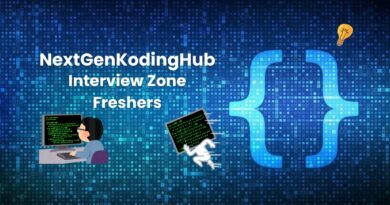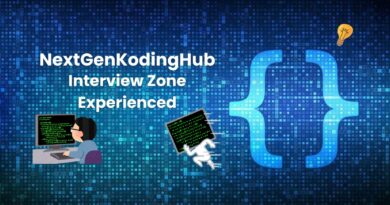Full Stack Interview Experienced
Interview Zone: Full Stack Prep (Experienced)
Full Stack Interview Prep Experienced – 30+ Expert-Level Questions
For senior roles, Full Stack Interview Experienced is essential preparation, covering both client- and server-side architecture, performance, security, and deployment. This guide brings together over 30 advanced questions with detailed context and best-practice answers. By mastering these **Full Stack Interview Prep Experienced** questions, you’ll demonstrate full-stack fluency under pressure.
Furthermore, confidently responding to Full Stack Interview Experienced prompts emphasizes your versatility—from frontend rendering and API design to database modeling and CI/CD strategies. Ready to optimize your full-stack readiness? Let’s dive into expert-level topics.
1. Describe end-to-end data flow in a modern web application.
A full-stack expert explains how browser sends HTTP request to API, server processes it, queries database, formats response, and returns JSON. Then frontend renders the view. They also discuss caching layers, error handling, and performance considerations.
2. How do you optimize frontend performance?
Use code splitting, lazy loading, tree shaking, image optimization, service workers, Brotli compression, and resource hints like preload. Monitor paint metrics like FCP and TTI using Lighthouse or RUM.
3. Explain authentication and session management end-to-end.
Implement login via OAuth or JWT. Store tokens securely—HTTP-only cookies or local storage with XSS safeguards. Use refresh tokens. Validate on server, handle revocation, and secure logout flows.
4. What are RESTful vs GraphQL endpoints?
REST endpoints define static resources per URL. GraphQL exposes a single endpoint with flexible queries. Backend handles resolvers, batching, caching, and client requests reduce over-fetching while increasing complexity.
5. Describe database schema design for a social feed.
Outline user, post, comment tables. Add indexes for users or timestamps. Use pagination via keyset, cover many-to-many with junction tables. Plan for sharding and caching.
6. How do you ensure API versioning and backward compatibility?
Use URI versioning (/v1/users), header versioning or hypermedia. Manage schema migrations carefully, deprecate fields, and document changes to avoid client breakage.
7. Explain server-side caching strategies.
Use in-memory (Redis, Memcached) or HTTP caching. Implement cache-aside, write-through, and TTL. Invalidate on writes. Mitigate stampede with locks or coalescing.
8. How do you handle file uploads and storage?
Accept streaming uploads, validate file types/sizes. Upload to object stores (S3, GCP). Use presigned URLs, CDN integration, and background virus scanning.
9. What deployment architecture would you choose?
Use Docker and Kubernetes or serverless (Lambda/FaaS). Manage deployments via blue-green, rolling updates. Automate via CI/CD pipelines with smoke testing and rollback.
10. How do you optimize API performance?
Use HTTP/2 multiplexing, gzip/Brotli compression, pagination, connection pooling, and limit payload sizes. Monitor latency metrics and scale with horizontal pods or instances.
11. Explain full-text search integration.
Use Elasticsearch or database full-text features. Define analyzers, mappings, synonyms. Handle indexing, pagination, ranking, and consistency between main DB and search index.
12. Describe error tracking and observability.
Use structured logging with trace IDs, metrics tracing via OpenTelemetry, and error tracking tools like Sentry. Correlate logs from frontend and backend.
13. What are container best practices?
Use minimal base images (Alpine), multistage builds, environment separation. Do not run root. Implement liveness/readiness probes in orchestrators like Kubernetes.
14. How would you design real-time updates?
Choose WebSockets, Server-Sent Events, or polling. Use heartbeat, scale via pub/sub brokers, failover strategies, and fallbacks for legacy browsers.
15. Explain rate-limiting and throttling full-stack strategies.
Implement rate-limits at API gateways or middleware, and apply global/population-based throttling. Use distributed token buckets or sliding window counters.
16. What is CDN integration for static and dynamic content?
Use CDNs to serve static JS/CSS/images. For dynamic content, cache at edge layers (via Varnish, CloudFront). Manage TTLs and invalidation seamlessly.
17. How do you secure data at rest and in transit?
Enforce TLS 1.2+, encrypt database disks and storage buckets. Manage keys via Vault or KMS. Secure backups and rotate credentials.
18. Describe Micro-frontend architecture.
Split frontend into smaller apps compiled and deployed independently. Use iframes, Web Components, or runtime integration. Ensure shared component libraries and routing coherence.
19. How do you implement full test coverage?
Employ unit tests (Jest, pytest), integration tests (API endpoints), E2E (Cypress), and contract testing (Pact). Integrate into CI/CD with coverage thresholds.
20. Explain migration strategy when evolving data schemas.
Use migration tools (Flyway, Liquibase), write backward-compatible updates, offload background migrations, and rollback in staging before production deployment.
21. How do you handle session storage in distributed systems?
Use stateless JWTs or sticky sessions with load balancers. Or, store session data in Redis or DynamoDB and scale horizontally without losing user context.
22. Explain CI/CD pipeline for full stack apps.
Automate linting, testing, building, containerization, and deployment. Include canary releases, security scanning, and monitoring integration in pipelines.
23. What monitoring dashboards do you build?
Include metrics on latency, error rates, throughput, database metrics, and user journey timings. Use Grafana, Prometheus, or commercial APM solutions.
24. Describe backend for frontend (BFF) pattern.
BFF acts as API gateway for frontend. It aggregates calls, adapts data shape, and handles security concerns. It isolates frontend from backend complexity.
25. How do you manage long-running tasks?
Use message queues (Kafka, RabbitMQ) and worker pools. Design idempotent workers, handle retries, and monitor dead-letter queues.
26. Explain content versioning and cache busting.
Use hashed file names or query params for static assets. Automate during build, purge CDN on deploy, and maintain cache-control policies.
27. What is rate-limited circuit breaker at full stack?
Integrate circuit breakers at backend service calls or API gateways. Rate-limit failing services, fallback gracefully, and log incidents.
28. How do you support multi-tenant architectures?
Use schema-level or row-level tenancy. Clearly isolate user data, consider naming conventions, index inclusion, and policy enforcement in backend.
29. Explain A/B testing infrastructure.
Use feature flags, track metrics per variant, run tests on frontend and backend. Analyze performance and monitor business impact.
30. Describe full-stack debugging approaches.
Correlate logs from frontend and backend using trace IDs. Use dev tools, database query logs, and error tracking tools together to isolate issues end-to-end.
Bonus: How do you architect multi-region deployments?
Replicate databases with eventual consistency, route traffic via geo-DNS, and handle active-active or active-passive failover with health checks.
Final Thoughts
These **Full Stack Interview Prep Experienced** questions cover architecture, performance, security, data flow, and deployment. Practice by building prototypes, writing diagrams, and adapting answers to real scenarios. As you refine these concepts, you’ll project the confidence and depth expected of a senior full-stack engineer. Best of luck in your interviews!



